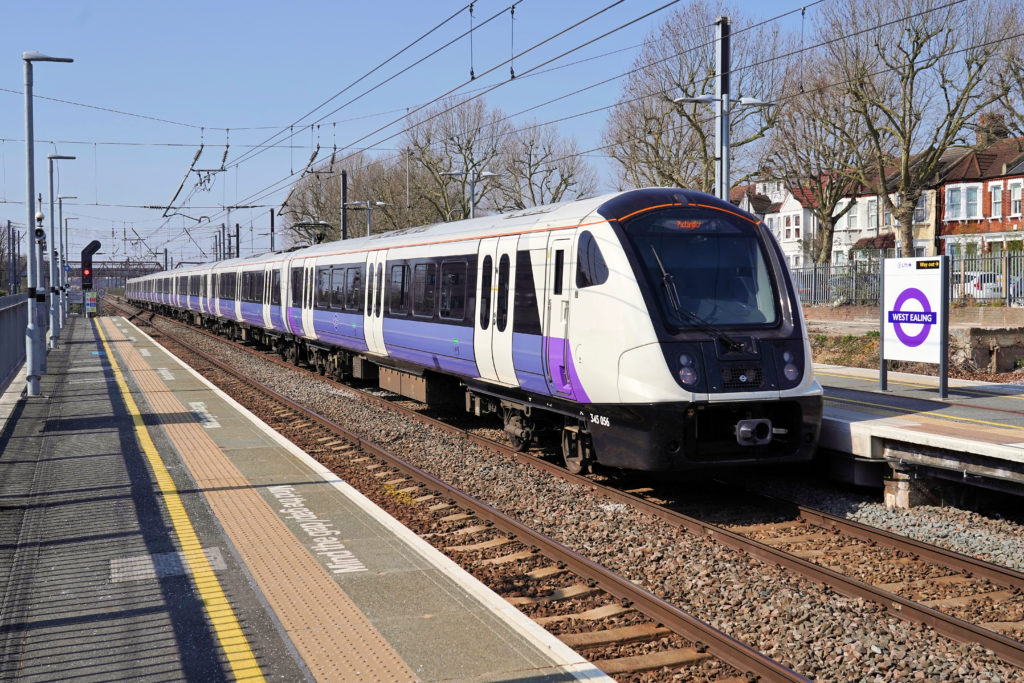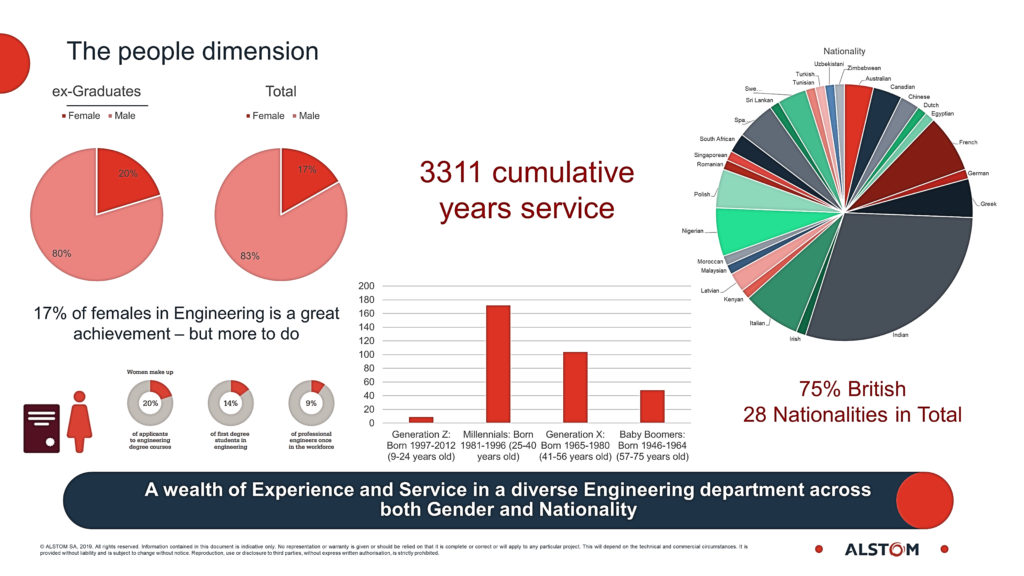The UK’s railway rolling stock workshops have a proud history. Antecedents of Alstom include Robert Stephenson & Co. (manufacturer of the Rocket) which was founded in 1823 and was taken over by English Electric in 1944. In 1969, English Electric merged with GEC which became GEC Alsthom in 1989, and Alstom in 1998. In 1843, Crewe Works was opened by the Grand Junction Railway and Derby Litchurch Lane was opened by the Midland Railway in 1876. Both became part of British Railways in 1948, before being sold to a consortium including staff in 1988, becoming Adtranz in 1996. Adtranz was acquired by Bombardier in 2001. Alstom acquired Bombardier in 2021.
It was against this historical background that Mike Hulme, engineering director Alstom UK introduced his George Ramshaw Memorial Lecture (see panel) entitled Testing the New Alstom: the Bombardier Acquisition One Year On. His talk focussed on the UK, but the impact of this acquisition will have been felt by everyone employed in both businesses worldwide. Mike said that he was particularly struck by a sentence in George Curry’s brief biography, explaining that George: “…was known for always being conscious that, in a technology-based industry, it was people who made things happen.” Mike reiterated that Alstom may well be an organisation that produces technologically sophisticated products but it is the people employed by the company, its customers, and its suppliers that make it happen.
Mike’s lecture covered the challenges Alstom faced with the acquisition of Bombardier Transportation. These included the different cultures, and systems, terms and conditions (both suppliers and people), combining systems, tacking major challenging projects and rebuilding a struggling Bombardier supply chain whilst combining it with Alstom’s. Mike said he was pleased to find a very positive can-do attitude from both organisations to work together to resolve the major problems.
Alstom UK and Ireland 2022
Alstom now employs some 6,000 people in 33 locations across UK and Ireland (UK&I), including four large sites and 24 depots. It is a major signalling and infrastructure business and its Derby, Litchurch Lane factory is the UK’s and Alstom’s largest, measured by output. Fifty percent of all UK and 100% of London Underground/Overground journeys are made on Alstom trains and Alstom supports 66% of the UK fleet.
Derby, with a team of 2,200 people, is manufacturing a total of 2,660 Aventra vehicles of which about half have now been delivered on top of the 4,500 cars delivered in the last decade. The factory is also building 280 monorail vehicles for Cairo.
The Alstom Services organisation employs approximately 3,000 people over 28 sites supporting high speed, regional, metro, LRV rolling stock and locomotives.

The combined rail systems and infrastructure business has a team of more than 750 people in the UK and Ireland. It is Network Rail’s largest CP6 signalling supplier and the largest supplier of ETCS onboard systems within the UK&I and is also the centre of excellence for the popular EBItrack track circuit. Alstom is also an infrastructure supplier and is part of the ATC joint venture that fitted the track, rigid overhead conductor, and rail systems for the new build Crossrail central section.
Using the metaphor of “the Good, the Bad and the Ugly”, Mike described progress over the last year or so since the takeover, and the seven months since he arrived at the Derby factory to lead the engineering and design team of 400.
The good
Mike was positive about the Aventra platform. Alstom had been absent from the UK new build market since trains based on the Juniper and Coradia platforms were built in the early 2000s. He saw the benefits of the “complete knock down (CKD)” assembly process, which sees equipment and wiring installed on underframe, sides, ends, and the roof, before assembly into a vehicle. This results in better quality and lower production cost with just a little more weight. And the platform is highly adaptable. He emphasised the platform concept, as the 2660 vehicles delivered or on order have a variety of different configurations including DC power and 25kV, three different cab designs, different vehicle lengths, different door layout. “That’s six different projects for six different customers but all drawing on a common set of Aventra building blocks” he said.
The bad
All the positivity of the basic design could not disguise the serious problems that Alstom had to deal with when it took over at the start of 2021. The supply chain was suffering serious cash flow issues, due mainly to Bombardier’s well publicised issues arising from its aircraft manufacturing business. There were shortages of critical materials, yet anyone walking around the factory would see a huge amount of material in stock. Moreover, hundreds of part-completed cars were stored at Derby and other sites, each of which required an individual rectification plan to bring it up to the correct configuration. The first action was to inject finance into the supply chain to stabilise the position, whilst planning the rectification of part completed cars and deal with the remaining disruption caused by Covid.
The ugly
“The headlines were awful before we took over”, said Mike. Delays, workers being laid off, and payments to suppliers were just some of the problems highlighted. Indeed, the situation was so bad that none of the trains for some fleets had been accepted by the time the original contract stipulated they should all be in service. Some of this was Covid-related, but not all.
Alstom took a “start as you mean to go on” approach, said Mike, “ensuring that the design is frozen before sub assembly and car production begins, minimising modifications and ensuring they happen on the line not after, and having one rather than repeated test stages before acceptance and what we call ‘on time delivery’ to the customer”.

Any engineer would recognise the importance of settling the configuration before starting the build. If the configuration is agreed, and the vehicles are built well in accordance with that configuration, then there will be confidence that the vehicles can be sold.
Mike reported that there are now signs of improvement, with all the Crossrail trains and more than 60 of Greater Anglia’s class 720 5-car trains delivered, and just a few of London Overground’s class 710 units to go. Reliability is also improving.
When Rail Engineer asked Mike what he thought his biggest remaining challenge was, he replied: “Aventra is a good basis for improved quality, but there is still much to do. The mechanical side is sound; still some issues but nothing that is insoluble. The big issue is still the complex internet protocol train control and monitoring system (TCMS). This requires significant integration between many subsystems each of which has its own software. When it works well there are enormous benefits in terms of performance monitoring and maintenance planning, but we have more work to do.”
People
One of the highlights Mike found was the composition and age profile of the Derby engineering team. Bombardier had been active in recruiting a diverse workforce, Mike said, adding that his team had over twice the national average percentage of female engineers, and 25% of his workforce were from 28 different countries. Positively for the railway industry, it is a young team with about 60% of the team under 40, compared with the most rail companies where the majority is usually over 40. Mike said: “I have been very impressed with the demographics of the Derby engineering team on age, gender, and ethnicity. It makes Derby even more of an asset.”
The future
Mike compared and contrasted the three available technologies for zero carbon operation; in each case powered by electricity either from the overhead catenary, from batteries, or from a hydrogen/battery system such as Alstom’s iLint (covered in issue 145, November 2016). The Aventra platform can be provided with any of these power sources.
The immediate future is the order for HS2’s trains, placed in December 2021 with the Alstom/Hitachi joint venture. Hitachi will build the carbodies and fit the traction and TCMS at Newton Aycliffe, while Alstom will manufacture the Derby-designed bogies in Crewe and fit out the trains in Derby. The Derby team will design the interiors with support from Alstom’s high-speed team based in Hennigsdorf Berlin.
Fifty-four of these state-of-the-art trains have been ordered at a cost of some £2 billion, covering manufacture and the first 12 years of maintenance. They will be 360 km/h, 8-car, 200-metre-long trains – a total of 432 cars. Each 8-car unit will have four motor and four trailer cars. Carbodies will be welded aluminium and there will be a high level of regenerative braking. Separate pantographs will be fitted for the conventional and HS2 lines, and onboard ETCS will be installed from new. The trains will be maintained at a new depot at Washwood Heath (where the old Metro-Cammell factory was located) and north of Crewe. Testing is planned over the period 2026 to 2030, with maintenance obligations beginning when the customer starts taking over the trains.

Mike concluded by saying: “We have a leading position in rolling stock, train maintenance, and a strong position in signalling, but with that leadership comes responsibility to the wider rail sector. The integration has gone well and we have learnt some valuable lessons too: investing in the supply chain, combining production, systems, and cultures, putting people first. Finally, we must all prepare for the future by using technology to tackle climate change, and by attracting the right people to our industry.”
George Ramshaw Curry
George Curry joined what was then the Locomotive Manufacturers’ Association as Assistant Director and was appointed Director in 1954. Over the next 31 years, he was responsible for the progressive expansion into the Locomotive and Allied Manufacturers Association and its transition, in 1971 to the Railway Industry Association (RIA). Retiring in October 1985, George had seen the gradual expansion of RIA’s membership, influence, and agenda. He was well-liked and was known for being conscious that, in a technology-based industry, it was people who made things happen. Many engineers and managers benefited from his personal interest in their careers.
Recognising his immense contribution to the railway industry, George was made a Companion of the Institution of Mechanical Engineers in 1985, a rare distinction awarded to those non-engineers who have rendered important services to mechanical engineering. He died in June 1986 after a brief illness but his legacy lives on, particularly through the IMechE organised annual George Ramshaw Curry Lectures.
Mike Hulme, engineering director, Alstom
Mike Hulme joined Alstom in 2001, initially as Validation Manager, Preston Transit. Since then, he has held senior positions in UK Transport Service, including Supply Chain Director West Coast Main Line, Engineering and Tender Director, Services Vice President and most recently Projects Director.
As engineering director, Mike heads Alstom’s UK capability in vehicle design and systems engineering including the 400 engineers based at Derby Litchurch Lane. Mike assumed the role soon after Alstom’s acquisition of Bombardier Transportation.
Mike has co-chaired the Northern Rail Industry Leaders Group focused on promoting the north’s rail industry, is on the Liverpool City Region LEP, and is an honorary professor at Aston University Business School, providing support and guidance for the Advanced Services Group.

